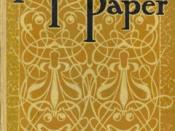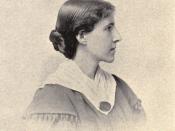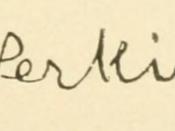In "The Yellow Wallpaper" by Charlotte Perkins Gilman, a woman who has been diagnosed with "temporary nervous depression" and her husband, John, supposedly stay in a colonial mansion for the summer. Her husband is a physician who believes that she is not truly sick. He won't allow her to write or to work and limits her to a small amount of exercise each day, the rest of the time keeping her hidden away in a large nursery at the top of the house. It is in this nursery that the wife gradually degenerates, crawling ever so slowly to the breaking point, until she finally loses it. Within this story are many clues to Gilman's feminist ideology, hidden ever so nicely behind descriptions of insanity and the nature of the men in her life.
Janice Haney-Perez writes in her article "Monumental feminism and literature's ancestral house: Another look at 'The Yellow Wallpaper'" that "...John
resolutely dismisses his wife's apprehensions by reminding her that...he is the one who really knows. From this point on, the narrator sees things otherwise; now the wallpaper's "outside pattern" is perceived as bars, while its sub-pattern is perceived to be a woman rather than something like a woman" (119). John is so controlling over every aspect of his wife's life, for she even states "I have a schedule prescription for each hour in the day; he takes all care from me, and so I feel basely ungrateful not to value it more" (Gilman, 89). She also explains how she had wanted a room downstairs that opened onto a piazza and had roses on the window and pretty hangings, but John wouldn't hear of it, so they stayed in the room that he chose. It is easy to see how the narrator begins...


